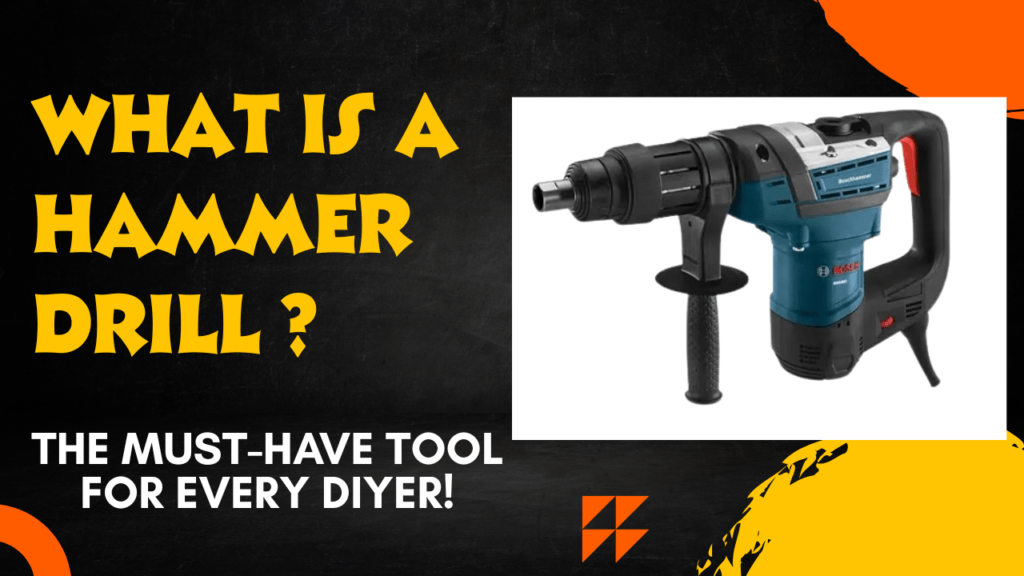
What Is a Hammer Drill?
A hammer drill is a powerful tool made for drilling into hard materials like concrete, brick, stone, and masonry. Regular drills often struggle with these tough jobs, but a hammer drill makes the work easier, faster, and cleaner.
This guide explains how hammer drills work, what they’re used for, the different types, safety tips, and how to take care of them.
How Does a Hammer Drill Work?
A normal drill only spins the drill bit. But a hammer drill adds a hammering action while it spins.
Inside the tool, a mechanism makes the drill bit quickly move forward and backward (in and out) while it rotates. This helps break up hard surfaces so the drill bit can cut through more easily.
Rotating Action: The drill bit spins to cut through the material.
Hammering Action: The bit also moves in and out very fast, breaking up hard surfaces like concrete.
Many hammer drills let you turn off the hammering action. This way, you can use it like a regular drill for softer materials like wood or metal.
Types of Hammer Drills
Standard Hammer Drill
These are smaller and lighter, good for light to medium jobs like drilling into brick or masonry. Perfect for home use or small projects. They come in both corded and cordless versions.
Rotary Hammer Drill
These are bigger, heavier, and much more powerful. They’re made for heavy-duty work like drilling large holes in concrete or chiseling. They use a piston system that delivers stronger hammering force—great for construction or industrial work.
Corded vs. Cordless Hammer Drills
Corded: Plugs into power for nonstop use. Stronger and better for long jobs.
Cordless: Battery-powered, easy to carry around, and great for quick or small tasks. Limited by battery life.
What Can a Hammer Drill Be Used On?
Hammer drills are best for drilling into hard building materials like:
Concrete: For walls, floors, foundations, and footings.
Brick & Masonry: For anchor holes or mounting shelves and fixtures.
Stone: Works on natural stone or man-made stone surfaces.
Tile & Ceramic: With the right drill bit and care, you can make holes for plumbing or wiring.
Wood & Metal: Can be drilled only when the hammering feature is turned off and you’re using the right type of drill bit.
Also read:
Dovetail Saws Explained: Simple and Clear
Marking Knife: How to Choose the Best One
Hammer Drill vs. Rotary Hammer: What’s the Difference ?
| Feature | Hammer Drill | Rotary Hammer Drill |
| Percussive Mechanism | Mechanical clutch that strikes | Piston-driven hammer mechanism |
| Impact Energy | Lower | Much higher |
| Suitable Hole Size | Usually up to ½ inch (13 mm) | Larger holes (up to several inches) |
| Weight | Lighter, more compact | Heavier, bulkier |
| Uses | Light to medium masonry drilling | Heavy-duty drilling & chiseling |
| Price Range | Generally less expensive | More expensive |
What Is a Hammer Drill Used For ?
Hammer drills are invaluable for tasks requiring precision holes in dense materials:
- Installing concrete anchors, bolts, and fasteners
- Mounting shelves, brackets, and fixtures on masonry walls
- Electrical & plumbing installations through block or concrete walls
- Outdoor construction projects like fences and decks with stone bases
- Tile drilling for bathroom or kitchen fittings
- Light demolition work on tile, brick, and plaster (with rotary hammer mode)
Drill Bits Used with a Hammer Drill
Masonry Bits: Usually carbide-tipped, designed to withstand the hammering action.
Multi-Material Bits: Suitable for a range of materials; some designed for hammer drill use.
Standard Twist Bits: Used only with hammer mode off for wood and metal.
Specialty Bits: Diamond-tipped bits for tile or stone.
How to Use a Hammer Drill Safely and Effectively
Wear Safety Gear: Eye protection, ear protection, and a dust mask.
Secure the Material: Clamp workpieces if possible.
Select the Appropriate Bit: Use masonry bits for concrete, disable hammer mode for wood.
Start Slowly: Begin with a slow speed to position the bit, then increase.
Maintain Firm Grip: Hammer drills generate more torque and vibration.
Work in a Well-Ventilated Area: Dust from concrete and masonry can be harmful.
Take Breaks: To avoid overheating the drill or bit.
Check for Obstructions: Like rebar or wiring inside concrete walls before drilling.
Maintenance Tips for Hammer Drills
Clean Regularly: Remove dust and debris after use.
Inspect and Replace Worn Bits: Dull bits reduce performance and can overwork the motor.
Lubricate Moving Parts: Follow manufacturer guidelines.
Battery Care: For cordless models, charge and store batteries correctly.
Check Power Cords: For cuts and wear on corded models.
Store Properly: In a dry, secure location.
Frequently Asked Questions (FAQs)
1. What’s the difference between a hammer drill and a regular drill?
A hammer drill both spins and “hammers” the bit forward to break tough materials like concrete. A regular drill only spins and works better on wood or metal.
2. Can I use a hammer drill on wood or metal?
Yes, but only if you turn off the hammering action and use the right bit for the material.
3.How many types of hammer drills are there?
There are mainly two types:
- Standard Hammer Drills – for lighter jobs
- Rotary Hammer Drills – for heavy-duty work and light demolition
4. What kind of drill bits do I need?
- Use carbide-tipped masonry bits for concrete, brick, and stone.
- Use standard twist bits for wood and metal.
5. Are hammer drills loud?
Yes, they’re louder than regular drills because of the hammering action. It’s a good idea to wear ear protection.
6. Can I get a cordless hammer drill?
Yes! Many cordless models are available. They’re great for working in places without easy access to power.
7. What size holes can a hammer drill make?
Most standard hammer drills can drill holes up to ½ inch (13 mm). For bigger holes, use a rotary hammer drill.
8. Can I use it for breaking things (demolition)?
Only rotary hammer drills can handle light demolition with special chisel bits. Standard hammer drills are not made for this.
Final Thoughts
A hammer drill is a must-have tool for drilling into hard materials like concrete, brick, stone, and masonry. It combines spinning and hammering actions to drill cleaner and faster.
Whether you’re doing home projects or working on a construction site, knowing the right type of hammer drill, how to use it safely, and which bits to use will help you work better and get great results.

